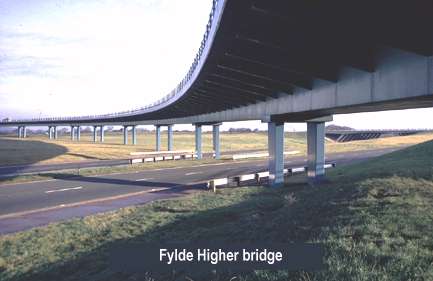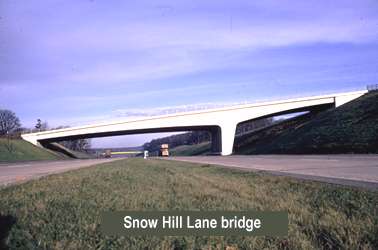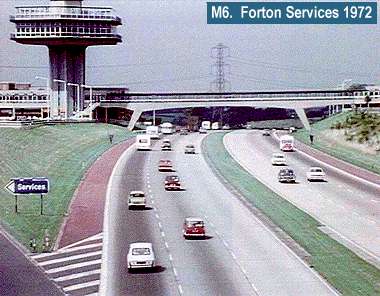With no intermediate interchanges along its 13½ mile length through an area which is rural in character it was, at that time, to be the longest stretch between junctions on a British motorway.
In order to minimise the extent of farm severance, the selected route was on the eastern side and immediately adjacent to the West Coast main line railway over a length of several miles. This had the effect of requiring an exceptional number of occupation bridges, over the motorway, to connect directly with those which had been provided when the railway was constructed in the 19th century.

Historically, all the north-south modes of transportation through this part of the country had followed a line on the eastern edge of the low-lying coastal plain close to the rising ground of the Pennine foothills. In consequence, therefore, within a corridor of less than half a mile wide south of Garstang there had been a Roman road; there was the Lancaster Canal still in use; there were traces of a turnpike road; and more recently, the mainline railway; the A6 by-pass of the town constructed in the 1930s; and in the 1960s there was to be the 'motorway'.
The southern interchange, at the northern end of Preston By-pass, had to cater for the future M55 serving the Fylde Coast. A conventional two-level layout with a roundabout would not have allowed continuous flow between the two motorways and so a three-level interchange was designed. It was the first of its kind in Britain and included the impressive eleven-span Fylde Junction Higher Bridge, 1300 feet in length. The main steel spine girder of box section 14 feet wide by 8 feet wide was welded in situ. Cantilever arms supported a reinforced concrete deck slab 44 feet wide between parapets.
The connection with the southern end of the Lancaster By-pass was to be a 'Trumpet' type of interchange providing full free-flowing movement through to the roundabout junction on A6.

Tenders were invited for three different types of carriageway construction namely flexible, semi-flexible and rigid. The lowest, which was accepted, provided for 12 miles of the length to have the dual three-lane carriageways constructed in concrete. Concern had been expressed, however, about the performance of concrete roads in the UK both in terms of the design standards which were in use and the adequacy of the available plant. Arrangements were made, therefore, for a visit to be made to the USA by the County Surveyor, as Engineer to the Contract, the Resident Engineer, and representatives of both the Contractor and of the cement industry, to examine current practice.
A number of recommendations were made to the Ministry of Transport for approval to be given for changes to be made in the design and specification, one of the most significant being the means of catering for the expansion of the concrete slabs which were to be laid mechanically. It had been found in the USA that, with closer spacing of the contraction joints, it was possible to eliminate expansion joints, which are notoriously difficult to form and maintain. However, the Ministry was not prepared to agree to such a major change but accepted a compromise that the spacing of the expansion joints could be increased to a maximum of 480 feet with contraction joints 40 feet apart.
A semi-flexible pavement construction was to be used on the slip road carriageways at the interchanges, at the approaches to the underbridges in order to reduce the effect of any differential settlement, and in the hard shoulders.
The Contract commenced in September 1962 and was scheduled for completion in April 1965.
It was estimated from the soil survey that a considerable proportion of the 3¼ million cubic yards of bulk excavation in the boulder clays, sand, silt, peat, shale and gritstone would be unsuitable for use in the construction of embankments. Provision was made, therefore, in the Contract, for importing suitable filling, with a requirement that it should be used in forming shallow embankments and in a two feet thick layer at the top of all other embankments. The effect was to ensure a more stable and consistent formation below the carriageway construction, than might otherwise have been the case.

The Contractor was able to obtain planning permission to open a borrow pit in a gravel deposit adjacent to the motorway and from it, other materials such as selected filling to drain trenches were obtained. Subsequently, a landscaped lake was formed, which provided an attractive environmental feature.
It was somewhat ironic that whereas progress on other contracts in progress during the early months of 1963 was seriously affected by severe frost, these conditions facilitated the excavation and removal of large quantities of unsuitable material, which otherwise would have been very difficult in normal circumstances.
Laid on a sub-base of crusher-run limestone, the 10½ inches thick reinforced concrete carriageway slab was to have a lower layer 7½ inches thick using limestone aggregate and a top layer with a granite aggregate to give a high skid resistance.

The Contractor adopted various methods unique to Britain by employing items of specially imported equipment to form a 'concreting train'. In order that it should operate as efficiently as possible, it was essential that it should be able to move forward at a steady rate. The earthworks, drainage, carriageway base and the majority of the forty-four bridges had therefore to be completed by the spring of 1964, to enable the concreting to be carried out during the summer. The concreting train could lay, in a single operation, the full thirty-six feet width of the slab for one of the carriageways. The maximum length laid in a twelve-hour working day was 2520 feet, a European record at that time.
In January 1965, this section of motorway, including the Service Area at Forton, was opened to traffic and the Snowhill Lane bridge carrying a minor road over the motorway at Scorton, received a Civic Trust Award. Apart from a short length of 3 miles north of Carnforth, the M6 in Lancashire was then complete. The design and supervision of the construction of the whole of the 62 miles of motorway with interchanges, 174 bridges and 12 miles of link and slip road had been undertaken by the County Council as the Agents for the Ministry of Transport.




